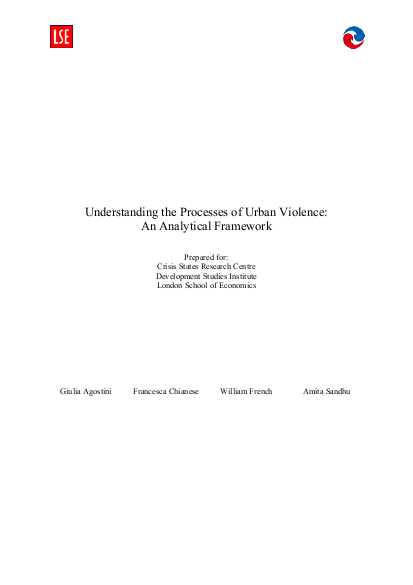
As of this year half of the world’s population is estimated to be living in cities1, therefore, an understanding of conflict and violence within an urban space is increasingly important. This paper’s output is an analytical framework, which examines the processes that lead from conflict to violence. Defining violence as the manifestation of distorted power relationships produced by the complex interaction between risk factors, the paper assumes that it is the interaction of these risk factors, which creates the processes that lead to violent outcomes. Risk factors are viewed as existing conditions that could potentially culminate in violence. Based upon a threefold taxonomy of violence, rooted in existing literature, three exemplary cities were chosen and analysed. These cities are Nairobi, Kinshasa, and Bogota, which respectively typify economic, political, and social violence. The cases demonstrate coinciding and context specific processes, with three significant points of overlap being identified: ?? The Primary Nexus: Is envisioned as the point where there is a significant alignment of common processes, and the point at which the potential for violence is extremely high. These processes are: a crisis of governance, unequal access to economic opportunity, economic decline, and the naturalisation of fear and insecurity. ?? Secondary Nexuses: Are the points of overlap between two of the case cities, where the potential for violence is significant, but not as likely as in the primary nexus. ?? Context Specific Processes: Highlight the unique manner in which risks factors interact to produce violence in each of the cities. This analysis led to the production of a two-stage analytical framework. These stages are not mutually exclusive, as an understanding of the first stage is essential for the second stage to be meaningful. The first stage is the contextualisation of the urban environment under examination, in order to understand the interaction between risk factors as they produce the processes leading to violence. While the second stage extracts these processes for the purpose of comparison to the processes that constitute the primary nexus. An alignment of processes should be viewed as an indicator of the high potential for violence within the urban environment being examined, however, processes are understood to be summative in nature, and thus, the more processes present, the more likely it is that violence will occur. In addition to the production of a framework, the analysis demonstrates how the interaction between risk factors creates processes leading to violent outcomes. As a policy conclusion, given that processes are the result of this interaction and that they are difficult to influence or change in and of themselves, a focus on prevailing risk factors is suggested in order to mitigate urban violence. 1 UN-
Resource collections
- UN Habitat - Urban Response Collection
- Urban Response - Urban Crisis Preparedness and Risk Reduction
- Urban Response Collection - Community Engagement and Social Cohesion
- Urban Response Collection - Economic Recovery
- Urban Response Collection - Environment and Climate Change
- Urban Response Collection - Housing, Land and Property
- Urban Response Collection - Urban Crisis Response, Recovery and Reconstruction
- Urban Response Collection - Urban Resilience